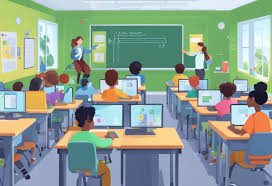The relationship between education and entertainment has evolved dramatically in recent decades, with innovative teacher practices increasingly incorporating popular media as pedagogical tools. Among these resources, kids animated shows have emerged as particularly valuable assets in the modern classroom, offering unique opportunities to engage young minds while delivering meaningful educational content.
Progressive educators recognize that children’s animated programming often contains sophisticated themes, complex narratives, and valuable learning opportunities that extend far beyond simple entertainment. When a teacher thoughtfully selects and contextualizes animated content, they tap into children’s intrinsic motivation and enthusiasm, creating powerful learning moments that resonate more deeply than traditional instructional approaches might achieve alone.
The neurological benefits of using animation in educational contexts are well-documented. Research in cognitive development indicates that the combination of visual storytelling, character identification, and emotional engagement activates multiple brain regions simultaneously, potentially strengthening neural connections associated with learning and memory. This multimodal stimulation helps children process and retain information more effectively, particularly for abstract concepts that might otherwise be difficult to grasp.
Animation also provides valuable opportunities for differentiated instruction. Visual learners benefit from the rich imagery, auditory learners connect with dialogue and music, and kinesthetic learners can be encouraged to physically respond to or recreate elements from animated sequences. This multisensory approach allows teachers to address diverse learning needs within a single classroom community, ensuring that all students can access curriculum content through channels that work best for their individual processing styles.
The strategic use of animated content also helps teachers bridge cultural and linguistic differences within diverse classrooms. Visual storytelling transcends many language barriers, making animated content particularly valuable for supporting English language learners and students with language processing challenges. When verbal comprehension is supported by clear visual context, children can more readily access meaning and participate more fully in classroom discussions.
Beyond academic content, animated shows offer powerful vehicles for social-emotional learning. Many contemporary programs explicitly address themes like empathy, conflict resolution, emotional regulation, and inclusivity—all crucial components of a well-rounded education. Teachers can use these narratives as starting points for deeper classroom conversations about interpersonal skills and character development, topics that might otherwise be challenging to address in concrete, relatable terms.
Critical media literacy represents another valuable educational dimension of incorporating animation into classroom practice. By analyzing how animated stories are constructed—examining character development, narrative structure, visual symbolism, and underlying messages—teachers help students develop sophisticated analytical skills applicable across disciplines. These discussions transform passive consumption into active engagement with media, fostering the critical thinking abilities essential for navigating our information-rich society.
Teachers who successfully integrate animated content into their practice typically approach it with intentionality and pedagogical purpose. Rather than using shows as mere time-fillers or rewards, they carefully select segments that align with specific learning objectives, prepare thoughtful discussion questions, and create activities that extend the viewing experience into deeper learning opportunities. This structured approach maximizes educational value while minimizing concerns about excessive or inappropriate screen time.
The accessibility of streaming platforms has dramatically expanded the range of animated content available to educators, including international programming that introduces students to diverse cultural perspectives. Teachers can now readily access animated stories from around the world, exposing children to different artistic traditions, storytelling conventions, and cultural values—an important foundation for global citizenship in our interconnected world.
Parent-teacher partnerships around media consumption represent another benefit of thoughtfully incorporating animation into educational practice. By discussing the educational value of specific shows with families, teachers help parents make informed choices about home viewing habits and create consistency between school and home learning environments. These conversations also empower parents to engage more actively in their children’s media experiences, asking questions and extending learning beyond passive watching.
Technology integration skills developed through working with animated content transfer to other educational technologies as well. Teachers who become comfortable evaluating and implementing animated resources often gain confidence with other digital tools, gradually expanding their technological repertoire in service of enhanced learning experiences. This ongoing professional growth benefits students across all aspects of the curriculum.
The pandemic-era shift to remote and hybrid learning accelerated educator interest in high-quality animated resources, as many teachers discovered that engaging animated content could effectively bridge physical distance during online instruction. This experience has permanently expanded many educators’ perception of animation as a legitimate educational tool rather than merely recreational content, with lasting implications for post-pandemic teaching practices.
Animation can also make challenging or potentially sensitive topics more approachable for young learners. Complex social issues, historical events, or scientific concepts can be introduced through age-appropriate animated narratives that provide emotional safety while still addressing important content. This approach allows teachers to engage with meaningful curriculum without overwhelming students or creating unnecessary anxiety.
In conclusion, the thoughtful integration of animated programming into educational practices offers multifaceted benefits for contemporary classrooms. Far from representing a distraction from serious learning, high-quality animated content can deepen engagement, enhance comprehension, support diverse learners, and address crucial social-emotional development. Forward-thinking teachers who recognize and harness these possibilities create richer, more inclusive learning environments that honor children’s interests while advancing important educational objectives.

